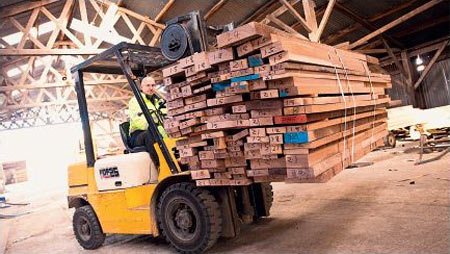Hardwood or softwood?
Do you know the difference between hardwood and softwood? Or why it is essential to let wood settle in before you use it?

Hardwoods tend to be deciduous meaning they lose their leaves in winter. While most hardwoods are indeed hard, some are soft. Balsawood is the softest commercially available hardwood and is softer than most softwoods!Softwoods, the most common being pine, are usually coniferous and tend to keep their leaves all year round. While most softwoods are – you guessed it – soft.
Before reaching the workshop
Regardless of whether the wood you use comes from a mainstream DIY store or a specialist timber supplier,
it all goes through a similar process before it’s usable in any kind of domestic project, the likes of which tend to adorn the pages of Good Woodworking. After a tree is felled it has to be converted into planks ready for drying. Once planked, the next stage is to season the timber. Seasoning refers to the process of reducing the moisture content within timber in a controlled manner. This is achieved in one of two ways, or often a combination of the two. The first method is kiln drying where sawn timber is stacked in a heat and moisture controlled sealed space with a continuous air flow to bring the moisture content down over a period of weeks. This expensive process has to be carefully controlled because if the timber is dried too quickly it can lead to a breakdown of the woods internal structure which, in turn, leads to all sorts of problems later on. Other problems can occur too, such as case hardening where the outside of timber dries at a much quicker rate than the inside. This becomes evident as the drier outside layer shrinks and splits as it no longer fits around the wetter, larger core. Due to the expensive nature of kiln drying, getting the correct balance between speed and ample drying time is crucial if the wood is to be of sufficient quality and competitively priced. The second method is air drying which takes much, much longer than kiln drying. We’re talking years instead of weeks here. The rule of thumb requires a hardwood plank be air dried for one year for every inch of thickness plus an additional year. Air dried timber often spends a short period of time in a kiln at the end of the drying process to bring the moisture content down to a usable level.
Why is moisture content important?
There is a general misconception that once wood has been seasoned you don’t need to worry about its moisture content anymore. However, wood continues to expand and contract after the initial drying process is complete. In fact wood, even with a synthetic finish applied, will continually adapt to the ambient moisture level that
surrounds it. It’s a slow process so you’re not going to see your wood move the minute you open a window but it will move over a period of weeks to match the average conditions around it. It is for this reason that the construction methods we opt to use must take into account this continual movement and allow the timber to adapt without stressing our joints. If we dont take this approach we end up with splits, cracks, warps, gaps and all manner of undesirable things.
How does wood move?
Wood expands and contracts most noticeably across its grain i.e. at right angles to the grain direction. It expands and contracts both in width and thickness, but not significantly in length, as it adjusts to the fluctuating temperature and humidity levels that surround it. Other factors such as the timber species and the way it was cut during the initial conversion process also have a bearing on the amount of movement that will take place but these are concepts beyond the scope of this article. The important fact to remember at this stage is that the timber movement is most noticeable across the width of a
board and its because of this predictability of movement that we use the construction methods we do when building furniture.
Controlling movement
Once you’ve acquired your seasoned timber the best thing to do is bring it indoors for approximately six weeks
prior to using it. Ideally it should be stored in the same room as it will eventually live as a piece of finished furniture but this is, more often than not, too impractical. As a compromise it’s a good idea to find an area of your house that approximates the same conditions as the room where the finished piece will live and store the timber there for a time. After a period of several weeks the moisture content of your timber should have adjusted to a level that you can safely use but it’s still vital that before you make anything you design its construction around the way that timber moves, because it will move!


Comments
Add comment